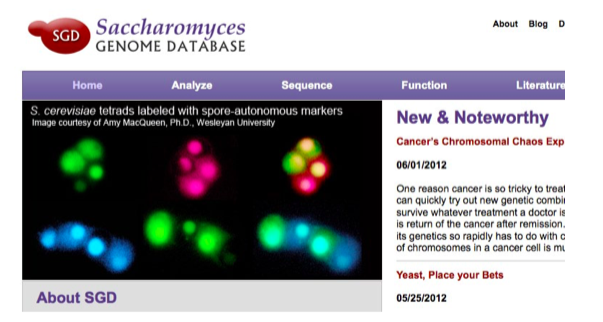5.5: Exercise 2- Using the Saccharomyces Genome Database
- Page ID
- 17521
The Saccharomyces Genome Database (SGD) is an important resource for the yeast research community. The SGD is a heavily curated database that draws from many other data- bases to provide a comprehensive view of a gene and its protein product, regulation of the gene’s expression and the role of the protein in cell function. It also serves as a virtual meeting place that welcomes contributions from the community. This exercise will introduce you to some use- ful resources at the SGD.
Direct your browser to: http://www.yeastgenome.org
For mobile devices, a Yeast Genome app is available through iTunes
• Type the name of your MET gene in the search box. This brings up the summary page for your gene. Note that the systematic name for your gene is identical to the locus name as- signed by the genome project.
Record the standard name for your gene _________________
Are there alternative names (aliases) for your gene? What are they?
The standard names for many S. cerevisiae genes were originally assigned during classic genetic screens. A screen for mutants unable to synthesize Met, for example, might gener- ate a collection of mutant strains that would arbitrarily assigned numbers - met1, met2.....metN. Occasionally, the same gene might appear in screens for different phenotypes, in which case there may be both two different names for a gene. For example, MET5 is the same as ECM17, because met5 mutants were isolated in a screen for defects in the cell wall as well as screens for methionine auxotrophy. (ECM stands for extracellular matrix.)
What role does the product of your MET gene play in metabolism?
The MET genes that we are studying all encode enzymes involved in Met synthesis. These enzymes are parts of highly regulated pathways in cells. Find the “Pathways” field on the SGD summary page for your gene. You will see links to one or more pathways in which your gene’s protein product has been implicated. Experimental evidence supports these pathways, which are organized in the MetaCyc database of metabolic pathways.
- List the MetaCyc pathway(s) that your enzyme is involved in. If the enzyme is involved in more than one pathway, are the pathways related to one another? How?
- Click on one of the pathway links. Locate the position of your gene product in the pathway. What is the official name of the enzyme encoded by your MET gene?
- Under the name of your enzyme, you will see a number with 3 decimal points. This is the offi- cial classification given to the enzyme by the Enzyme Commission, which categorizes enzymes in very fine detail. The first number indicates the broad class of enzyme, e.g. hydrolase, trans- ferase, oxidoreductase. The subsequent numbers drill down to the kinds of bonds altered in the reaction and finally to specific substrates. Enzymes from different organisms with the same EC number are expected to catalyze the same reaction. Record the E.C. number. This E.C. number will be important later in the semester, when you evaluate whether homologs from other species are likely to catalyze the same reaction as the S. cerevisiae enzyme.
- Click on the E.C. number to see the reaction catalyzed by the enzyme.
- What are the substrates and products for your enzyme? Draw the structures of the substrate and product that are intermediates in methionine synthesis. (You do not need to draw the structures of other substrates/products such as ATP/ADP.)
- The position of your enzyme in the pathway will be important in the next experiment, where selective plating is used to identify your group’s met mutants.
What gene encodes the enzyme that catalyzes the PRECEDING step in the pathway? This step generates the substrate for the reaction that you are studying.
What gene encodes the enzyme that catalyzes the NEXT step in the pathway? The product of your reaction will be metabolized in this step.
Gene expression
The expression of a gene under different environmental conditions often provides clues to its physiological importance. Few genes are regulated autonomously. Instead, most genes encode proteins that are part of networks that help cells adapt to changes in environmental conditions. DNA microarrays offer investigators a method to monitor changes in the expression of thousands of genes in response to an environmental change. Genes that show similar patterns of expression are often members of a gene network. Yeast biologists have performed thousands of microarray experiments, providing a wealth of information for every yeast gene. (If you are unfamiliar with microarrays, you may find the following tutorial to be helpful: learn.genetics.utah.edu/con- tent/labs/microarray/.)
- Click the Expression tab at the top of your gene’s summary page at yeastgenome.org. The Expression Overview histogram at the top of the new page shows the number of experiments where the level of gene expression was altered with a change in experimental conditions. The results are expressed in log2 (2X) units, where 0 indicates no change, 1 indicates a 2-fold change, 2 a 4-fold change, etc.) The histograms show the results from thousands of experi- ments. In most experiments, the level of gene expression did not change or changed little. (This becomes clearer when you select a linear y-axis.) Expression levels increased in some experiments (red bars) and decreased (green bars) in others. Clicking a bar in the histogram brings up the specific experiments that provided those results under Annotations. What con- ditions produced the highest rates of transcription for your gene?
- Cursor down to “Similar Expression Profiles” (or use the link in the left panel) to find a graphical summary of genes that show similar patterns of regulation as your own gene-of- interest in multiple experiments (datasets). Connecting lines between genes indicates that their expression was correlated. The width of the connecting lines reflects the number of studies in which expression was correlated. A slider bar at the bottom of the graphic allows you to filter the number of studies where particular genes were co-expressed. Note that the number of coexpressed genes decreases as you increase the number of datasets.
At its most stringent (co-expression in the largest number of datasets), which genes are co- regulated with your MET gene? Look up the reactions catalyzed by their gene products. Do you notice any patterns in the genes that are coordinately expressed with your MET gene? Do any other genes in the Met biosynthetic pathway appear in the list?
At the least stringent setting, do genes outside of the Met and Cys biosynthesis pathway ap- pear? What are these? Hypothesize about why these new gene clusters would be co-regulat- ed with MET genes.
Phenotype information
In keeping with its mission to serve as a resource to the yeast research community, which includes many geneticists, the SGD also collects information on mutant strains and their phe- notypes. The deletion strains that we will be using in our experiments are unable to grow in the absence of methionine, but they may demonstrate additional phenotypes.
- Click the Phenotype tab at the top of the page for more information. Today, many pheno- types are being identified in high throughput experiments that often generate complex and/or subtle phenotypes. How does the number of phenotypes generated by high throughput stud- ies compare to the number of phenotypes discovered by classical genetics?
- We will focus on the more straightforward phenotypes that have been identified using classi- cal genetics. Click on the classical genetics bar in the histogram to bring up information on individual phenotypes under the annotation heading. What phenotypes are detected in null mutants (null mutants either lack the gene or produce an inactive protein)?
- Mutations in some MET genes have phenotypes associated with tellurium accumulation and resistance (Ottoson et al., 2010). Find tellurium on the periodic chart. How do you think tel- lurium is working?


